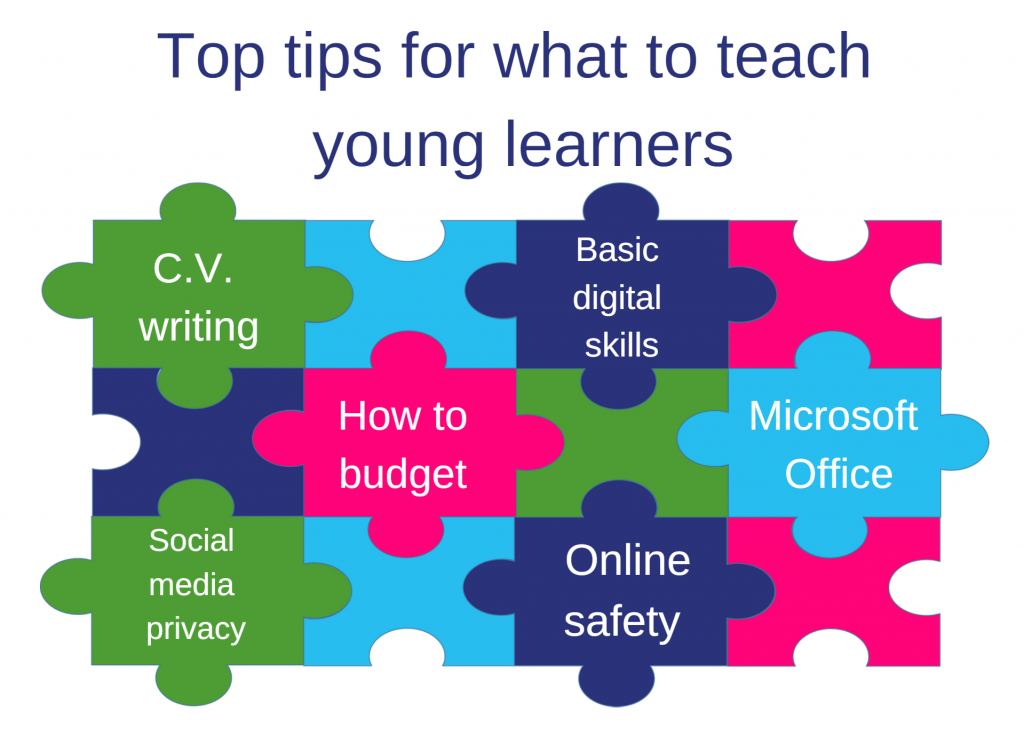Working with young learners

Research statistics show a need for young people to receive digital support. About 300 thousand young people lack digital skills and 700 thousand young people lack access to computer or tablet at home.
Young people who are already vulnerable are more likely to be digitally excluded.

Assumptions made about young people, and by young people, about their digital skills

Find out about the skills of the young people you are working with and design activities which support new skills



Resources
- Girl Guiding or Scouts badges & training including on digital skills, animation, and other
- Union learning Digital Skills programmes help people acquire skills to boost their job prospects and improve their employability
- Tech Mums free training programme to take the mystery out of technology
- Family Fund Digital Skills Programme & online videos – to help families with disabled children to develop their digital skills
- UK Youth skills development programmes for young people from predominantly disadvantaged backgrounds
- Downloadable, printable worksheet to help children aged 8-11 to think critically about what they do online, by OfCom – specific versions available for Scotland, Northern Ireland, Wales & a Welsh language version.
- Digital Access for All partnership to support young people’s access to digital
- Children’s University digital platform provides a fun, safe and secure online learning space
- Social Tech Trust ‘Digi Know’ programme provides training to youth workers and young Champions to deliver creative digital skills sessions
- Young Scot Digi Know fun ways to learn digital skills and how to stay safe online
- Save the Student equips young people in the UK with the knowledge, life skills and provision needed to manage their money
- Youth Employment UK resources to help tackle youth unemployment in the UK
- Digital Unite Technology Guides – hundreds of “how to” guides on various digital topics
- How to set up an inter-generational digital inclusion project – handbook by Age UK
- Digital Champions Network – Digital Unite’s unique training and support community for aspiring and experienced Digital Champions
- Learn My Way – free digital courses for learners and tutors
- UK Safer Internet Centre – the latest tips, advice and resources to help children and young people have a safe and positive time online
- Internet Matters – practical tips & guides to help parents keep their children safe online
- Online Safety & Privacy Resources – a suite of resources, guides and advice by SWGfL, a charity dedicated to empowering the safe and secure use of technology
Research, reports and publications
- Switched ON infographic by Carnegie UK – Key statistics related to digital inclusion for young people
- Switched ON report by Carnegie UK – Research and evidence about key issues related to digital inclusion for young people
- UK Youth Digi Know evaluation report – learnings, case studies and best practice
- Working with young people who are digitally excluded by Carnegie UK and UK Youth – presentation from our event about making digital accessible for everyone
- Digital access, skills and confidence among 11-18 year olds in the UK – a research paper by Lloyds Bank in partnership with the Learning Foundation
- News announcement about Girlguiding UK’s partnership with Google – to encourage more girls and young women to get involved in technology
- News announcement about GirlGuiding Scotland’s Digital Scotland Challenge Badge – to encourage girls of all ages to develop the skills they need for their digital future
- Charities, young people and digital mental health services – paper by Think NPC reviewing current digital mental health provision for young people
- Blog post from Family Fund, sharing their learning on running a digital inclusion project supporting families caring for young people with disabilities
- Digital Resilience, Inclusion & Wellbeing For Looked After Children & Young People – report by Snook, led by Glasgow City Health and Social Care Partnership, supported by the Carnegie UK Trust

Always remember that learners may not be typical of their group and may have multiple additional needs => Look at the other guides for tips and resources
Many thanks to our partners UK Youth and Carnegie UK who contributed to developing the learning on this topic